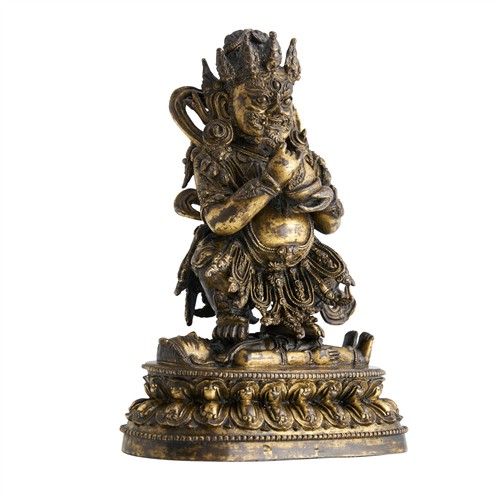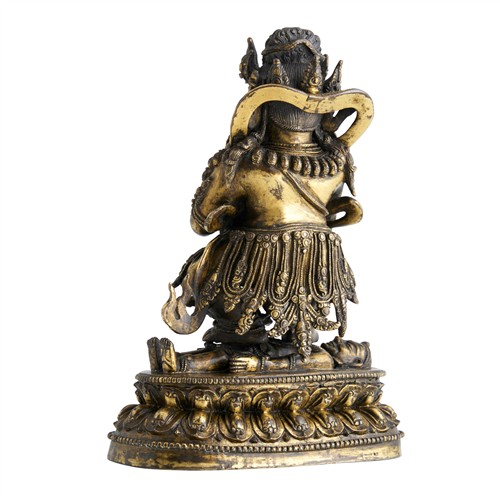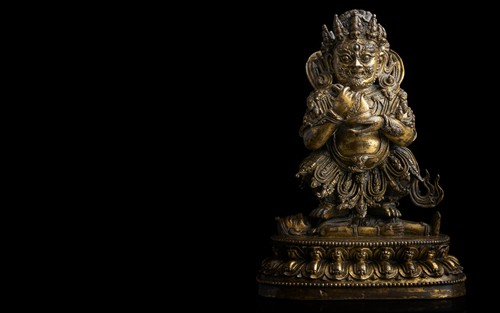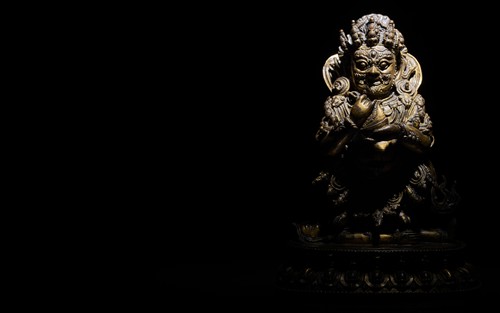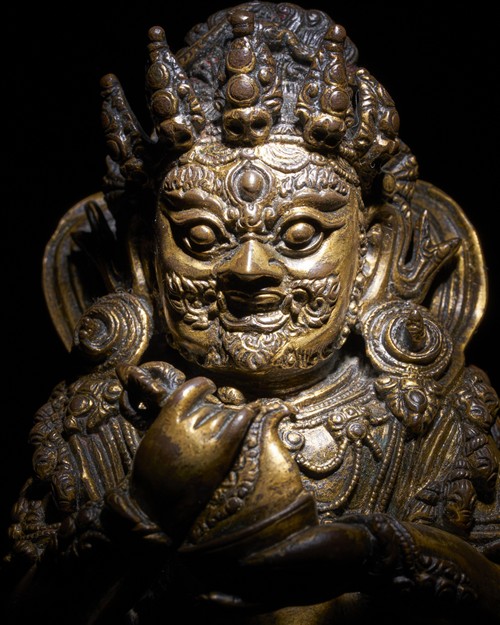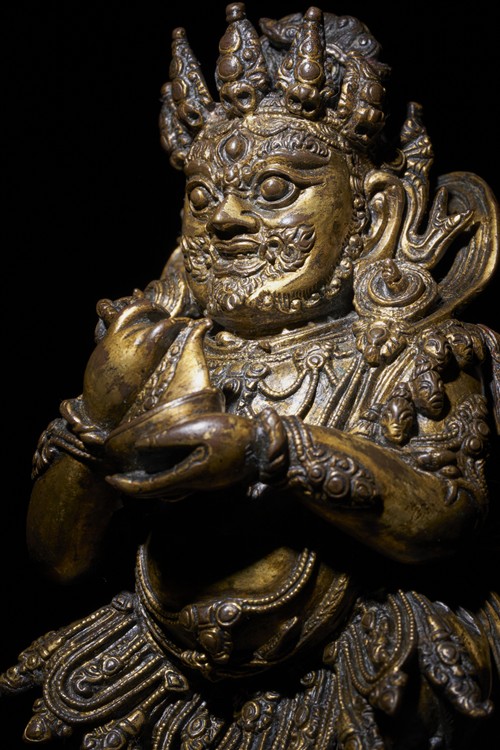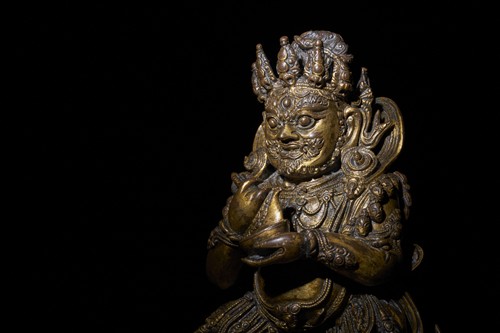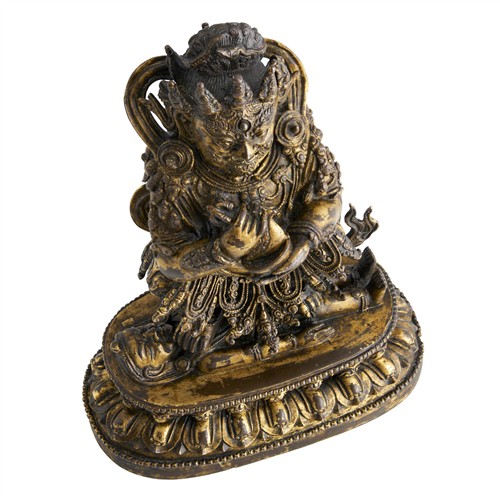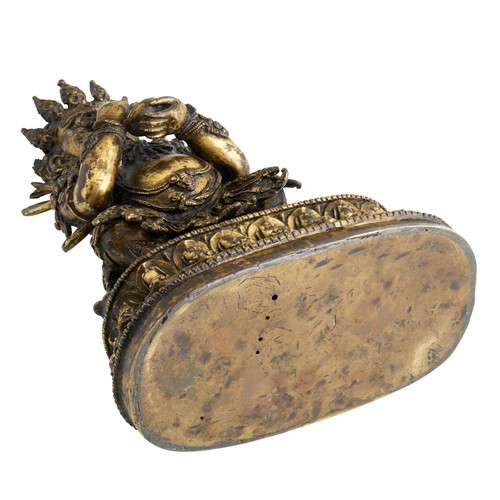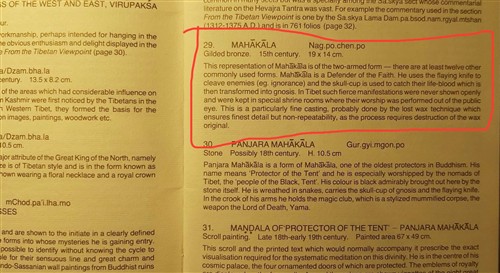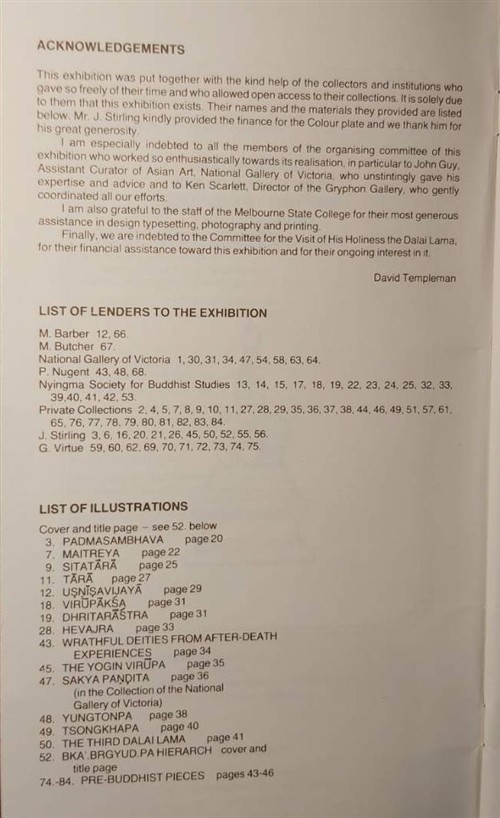Back
A RARE AND EXCEPTIONAL CHINESE GILT-BRONZE SEATED FIGURE OF PANJARNATE MAHAKALA, MING DYNASTY, YONGLE/XUANDE PERIOD, EARLY 15TH CENTURY
The crowned deity stands on a supine figure atop a double-lotus throne, wearing an elaborate apron and holding a skull cup in one hand. Finely cast with intricate detailing throughout.
Panjarnata Mahakala is frequently, though not invariably, depicted balancing a baton (Gandhi) in the crooks of his arms-a feature from which all other manifestations of Mahakala are believed to originate. Nonetheless, even in the absence of the baton, the deity's single face and two-armed wrathful form, wielding a kartri (ritual chopper) and kapala (skull cup), clearly identifies him as Panjarnata Mahakala, the revered "Lord of the Pavilion." He serves as the principal protector of the Hevajra Tantra cycle within the Sakya School, and his iconography and ritual practices are documented in Chapter 18 of the Vajra Panjara Tantra, as well as Chapters 25 and 50 of the Mahakala Tantras.
Although the present figure lacks an inscribed reign mark, its style closely aligns with the imperial gilt-bronze sculpture produced during the Yongle and Xuande periods. A closely related gilt-iron figure bearing a Yongle mark is housed in the Palace Museum, Beijing, and published in Splendors from the Yongle and Xuande Reigns of China's Ming Dynasty: Classics of the Forbidden City, Beijing, 2012, p. 247, no. 133. Another comparable Yongle-period gilt-bronze figure is in the collection of the Potala Palace, Lhasa, illustrated in The Times and the Styles of Statues of Buddha in Chinese Buddhism, Beijing, 2010, p. 216, fig. 234.
Further comparisons include a similar Panjarnata Mahakala figure, of nearly identical posture and attributed to the Yongle-Xuande period, which was sold at Christie's Hong Kong on 30 May 2018, lot 2863, for HKD 12,100,000 (approximately AUD 2,365,900). Another slightly larger gilt-bronze example from the same period was sold at Christie's Hong Kong on 29 May 2019, lot 2707, for HKD 9,245,000 (approximately AUD 1,807,665). Most notably, a larger example (72.5 cm high) bearing a Xuande mark was sold at Sotheby's Hong Kong on 26 November 2024, lot 3815, for HKD 40,800,000 (approximately AUD 7,977,583).
明永樂/宣德 鎏金銅宝帐大黑天金剛立像
般闍那他大黑天常見(但並非必然)於雙臂彎處橫持一根權杖(Gandhi),據說所有其他大黑天的化現皆由此而生。然而,即便權杖缺失,其單面雙臂、忿怒威猛的形象,手持鉞刀(kartri)與骷髏碗(kapala),亦可明確識別為般闍那他大黑天——被尊為“壇城之主”。此尊為薩迦派喜金剛續中的主要護法,其造像及儀軌記載於《金剛幕續》第十八章,以及《大黑天續》的第二十五與第五十章之中。
儘管此尊造像未見紀年款識,其風格與明代永樂及宣德年間的宮廷銅鎏金佛像極為相符。北京故宮博物院藏有一尊風格極為相似並帶有永樂款的鐵鎏金般闍那他大黑天像,著錄於《盛世華藏——明代永宣宮廷藝術》,北京,2012年,頁247,編號133。另有一尊永樂時期的銅鎏金般闍那他大黑天像,現藏西藏布達拉宮,刊載於《中國佛教造像藝術的時代與風格》,北京,2010年,頁216,圖234。
亦可參考數件市場上已錄得的相近拍品,包括一尊姿態幾乎相同、斷代為永樂至宣德時期的般闍那他大黑天像,售於佳士得香港,2018年5月30日,拍品編號2863,成交價為12,100,000港元(約合2,365,900澳元);以及一尊尺寸略大、同為明初時期的銅鎏金像,售於佳士得香港,2019年5月29日,拍品編號2707,成交價為9,245,000港元(約合1,807,665澳元)。最具代表性者為一尊高達72.5公分、帶有宣德款的大型般闍那他大黑天像,售於蘇富比香港,2024年11月26日,拍品編號3815,成交價高達40,800,000港元(約合7,977,583澳元)。
19cm high; 14cm wide; weight 2760g
Sold for $155,000
Lot 84
The crowned deity stands on a supine figure atop a double-lotus throne, wearing an elaborate apron and holding a skull cup in one hand. Finely cast with intricate detailing throughout.
Panjarnata Mahakala is frequently, though not invariably, depicted balancing a baton (Gandhi) in the crooks of his arms-a feature from which all other manifestations of Mahakala are believed to originate. Nonetheless, even in the absence of the baton, the deity's single face and two-armed wrathful form, wielding a kartri (ritual chopper) and kapala (skull cup), clearly identifies him as Panjarnata Mahakala, the revered "Lord of the Pavilion." He serves as the principal protector of the Hevajra Tantra cycle within the Sakya School, and his iconography and ritual practices are documented in Chapter 18 of the Vajra Panjara Tantra, as well as Chapters 25 and 50 of the Mahakala Tantras.
Although the present figure lacks an inscribed reign mark, its style closely aligns with the imperial gilt-bronze sculpture produced during the Yongle and Xuande periods. A closely related gilt-iron figure bearing a Yongle mark is housed in the Palace Museum, Beijing, and published in Splendors from the Yongle and Xuande Reigns of China's Ming Dynasty: Classics of the Forbidden City, Beijing, 2012, p. 247, no. 133. Another comparable Yongle-period gilt-bronze figure is in the collection of the Potala Palace, Lhasa, illustrated in The Times and the Styles of Statues of Buddha in Chinese Buddhism, Beijing, 2010, p. 216, fig. 234.
Further comparisons include a similar Panjarnata Mahakala figure, of nearly identical posture and attributed to the Yongle-Xuande period, which was sold at Christie's Hong Kong on 30 May 2018, lot 2863, for HKD 12,100,000 (approximately AUD 2,365,900). Another slightly larger gilt-bronze example from the same period was sold at Christie's Hong Kong on 29 May 2019, lot 2707, for HKD 9,245,000 (approximately AUD 1,807,665). Most notably, a larger example (72.5 cm high) bearing a Xuande mark was sold at Sotheby's Hong Kong on 26 November 2024, lot 3815, for HKD 40,800,000 (approximately AUD 7,977,583).
明永樂/宣德 鎏金銅宝帐大黑天金剛立像
般闍那他大黑天常見(但並非必然)於雙臂彎處橫持一根權杖(Gandhi),據說所有其他大黑天的化現皆由此而生。然而,即便權杖缺失,其單面雙臂、忿怒威猛的形象,手持鉞刀(kartri)與骷髏碗(kapala),亦可明確識別為般闍那他大黑天——被尊為“壇城之主”。此尊為薩迦派喜金剛續中的主要護法,其造像及儀軌記載於《金剛幕續》第十八章,以及《大黑天續》的第二十五與第五十章之中。
儘管此尊造像未見紀年款識,其風格與明代永樂及宣德年間的宮廷銅鎏金佛像極為相符。北京故宮博物院藏有一尊風格極為相似並帶有永樂款的鐵鎏金般闍那他大黑天像,著錄於《盛世華藏——明代永宣宮廷藝術》,北京,2012年,頁247,編號133。另有一尊永樂時期的銅鎏金般闍那他大黑天像,現藏西藏布達拉宮,刊載於《中國佛教造像藝術的時代與風格》,北京,2010年,頁216,圖234。
亦可參考數件市場上已錄得的相近拍品,包括一尊姿態幾乎相同、斷代為永樂至宣德時期的般闍那他大黑天像,售於佳士得香港,2018年5月30日,拍品編號2863,成交價為12,100,000港元(約合2,365,900澳元);以及一尊尺寸略大、同為明初時期的銅鎏金像,售於佳士得香港,2019年5月29日,拍品編號2707,成交價為9,245,000港元(約合1,807,665澳元)。最具代表性者為一尊高達72.5公分、帶有宣德款的大型般闍那他大黑天像,售於蘇富比香港,2024年11月26日,拍品編號3815,成交價高達40,800,000港元(約合7,977,583澳元)。
19cm high; 14cm wide; weight 2760g
Estimate $120,000 - $200,000
Overall, in good condition. The right ribbon is missing, and one paddle of the crown is bent. A small Buddha head from the crown is also missing. There is slight wear to the gilt, which is consistent with age and usage.
CLICK TO SEE DETAIL PHOTOS OF THE WHOLE AUCTION

